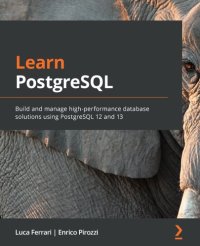
Ebook: Learn PostgreSQL: Build and manage high-performance database solutions using PostgreSQL 12 and 13
Author: Luca Ferrari Enrico Pirozzi
- Genre: Computers // Databases
- Tags: Auditing, Backups, Database Administration, Indexing, Logging, Monitoring, Partitioning, PL/pgSQL, PostgreSQL, Relational Databases, Replication, Security, SQL, Transactions, User Management, Window Functions
- Year: 2020
- Publisher: Packt Publishing
- City: Birmingham, UK
- Edition: 1
- Language: English
- pdf
A comprehensive guide to building, managing, and securing scalable and reliable database and data warehousing applications using Postgres 12 and 13
Key Features
- Set up your database cluster and monitor, secure, and fine-tune it for optimal performance
- Learn the fundamentals of database management and implement client- and server-side programming using SQL and PL/pgSQL
- Explore useful tips to develop efficient PostgreSQL database solutions from scratch
Book Description
PostgreSQL is one of the fastest-growing open source object-relational database management systems (DBMS) in the world. As well as being easy to use, it's scalable and highly efficient. In this book, you'll explore PostgreSQL 12 and 13 and learn how to build database solutions using it. Complete with hands-on tutorials, this guide will teach you how to achieve the right database design required for a reliable environment.
You'll learn how to install and configure a PostgreSQL server and even manage users and connections. The book then progresses to key concepts of relational databases, before taking you through the Data Definition Language (DDL) and commonly used DDL commands. To build on your skills, you'll understand how to interact with the live cluster, create database objects, and use tools to connect to the live cluster. You'll then get to grips with creating tables, building indexes, and designing your database schema. Later, you'll explore the Data Manipulation Language (DML) and server-side programming capabilities of PostgreSQL using PL/pgSQL, before learning how to monitor, test, and troubleshoot your database application to ensure high-performance and reliability.
By the end of this book, you'll be well-versed with the Postgres database and be able to set up your own PostgreSQL instance and use it to build robust solutions.
What you will learn
- Understand how users and connections are managed by running a PostgreSQL instance
- Interact with transaction boundaries using server-side programming
- Identify bottlenecks to maintain your database efficiently
- Create and manage extensions to add new functionalities to your cluster
- Choose the best index type for each situation
- Use online tools to set up a memory configuration that will suit most databases
- Explore how Postgres can be used in multi-instance environments to provide high-availability, redundancy, and scalability
Who this book is for
This Postgres book is for anyone interested in learning about the PostgreSQL database from scratch. Anyone looking to build robust data warehousing applications and scale the database for high-availability and performance using the latest features of PostgreSQL will also find this book useful. Although prior knowledge of PostgreSQL is not required, familiarity with databases is expected.
Table of Contents
- Introduction to PostgreSQL 12
- Getting to know your cluster
- Managing users and connections
- Basic Statements
- Advanced Statements
- Window Functions
- Server Side Programming
- Triggers and Rules
- Partitioning
- Users, Roles, and Database Security
- Transactions, MVCC; WALs and Checkpoints
- Extending the database: the Extension ecosystem
- Indexes and Performance Optimization
- Logging and Auditing
- Backup and Restore
- Configuring and Monitoring
- Physical replication
- Logical Replication
- Useful Tools and Useful Extensions
- Towards PostgreSQL 13